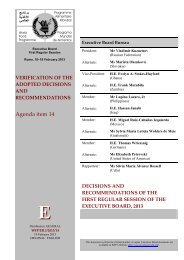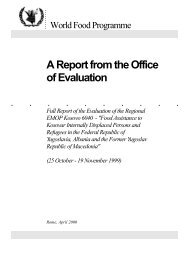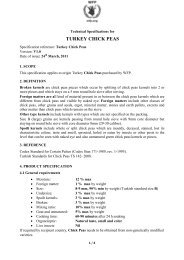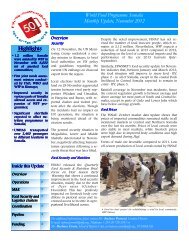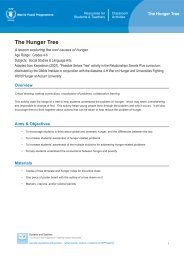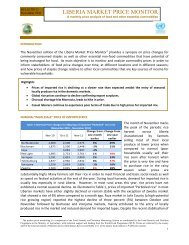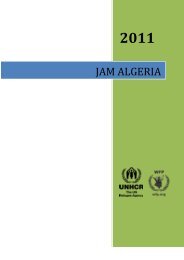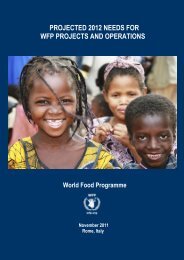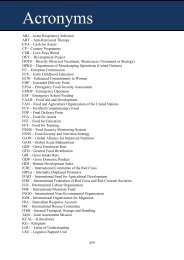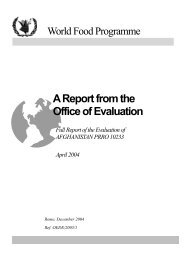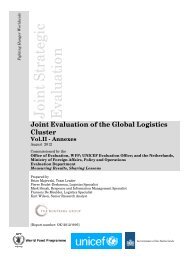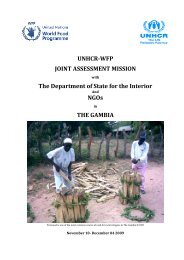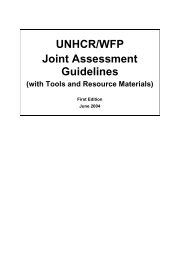The Potential for Scale and Sustainability in Weather Index Insurance
The Potential for Scale and Sustainability in Weather Index Insurance
The Potential for Scale and Sustainability in Weather Index Insurance
You also want an ePaper? Increase the reach of your titles
YUMPU automatically turns print PDFs into web optimized ePapers that Google loves.
88<br />
CASE STUDY 3<br />
INDEX INSURANCE IN ETHIOPIA – THREE PILOTS<br />
<strong>The</strong> follow<strong>in</strong>g graph illustrates an example of the use of LEAP software <strong>in</strong> calculat<strong>in</strong>g drought<strong>in</strong>dex<br />
value flow aga<strong>in</strong>st a trigger level. 20<br />
Ethiopia drought <strong>in</strong>dex value 1952-2002<br />
Ethiopia drought <strong>in</strong>dex value<br />
$90,000,000<br />
$80,000,000<br />
$70,000,000<br />
$60,000,000<br />
$50,000,000<br />
$40,000,000<br />
$30,000,000<br />
$20,000,000<br />
$10,000,000<br />
$0<br />
1952<br />
Source: Hess <strong>and</strong> Verlangieri (2009).<br />
1962 1972 1982<br />
Harvest Year<br />
Once the data are collected <strong>and</strong> the <strong>in</strong>dex is def<strong>in</strong>ed, it is necessary to identify the number of<br />
beneficiaries <strong>in</strong> the regional drought <strong>in</strong>dex. <strong>The</strong> Regional Water Requirement Satisfaction<br />
<strong>Index</strong> (RWSI) model was developed to elaborate such a correlation by us<strong>in</strong>g historical<br />
beneficiary numbers. <strong>The</strong> model is a weighted average of the WRSI computed by LEAP. In<br />
this model, the number of beneficiaries (N) <strong>in</strong>creases when the drought <strong>in</strong>dex decreases. As<br />
a result, when the drought <strong>in</strong>dex is large (mean<strong>in</strong>g that drought is not severe), the <strong>in</strong>crease <strong>in</strong><br />
beneficiaries is small, <strong>and</strong> when the drought <strong>in</strong>dex is small (mean<strong>in</strong>g that drought is severe),<br />
the <strong>in</strong>crease <strong>in</strong> beneficiaries is large. However, <strong>in</strong> the relationship between the number of<br />
beneficiaries <strong>and</strong> the RWSI, a failure level exists. This ‘F level’ shows the catastrophic<br />
conditions at which maximum livelihood protection assistance ef<strong>for</strong>t would be required (when<br />
the <strong>in</strong>dex reaches the F level, the entire population is at risk). 21<br />
Regional Water Requirement Satisfaction<br />
Number of Beneficiaries<br />
F<br />
Level<br />
1992 2002<br />
<strong>Index</strong><br />
Trigger<br />
0,00<br />
0 10 20 30 40 50 60 70 80 90 100<br />
Regional Water Requirement Satisfaction <strong>Index</strong><br />
20 Ibid; <strong>and</strong> Peter Hoefsloot presentation dur<strong>in</strong>g a meet<strong>in</strong>g of the M<strong>in</strong>istry of Agriculture <strong>and</strong> Rural Development<br />
<strong>in</strong> December 2009.<br />
21 S<strong>and</strong>ro Calmanti, Italian National Agency <strong>for</strong> New Technologies, Energy <strong>and</strong> Susta<strong>in</strong>able Economic<br />
Development (ENEA). Presentation dur<strong>in</strong>g a meet<strong>in</strong>g of the M<strong>in</strong>istry of Agriculture <strong>and</strong> Rural Development <strong>in</strong><br />
December 2009.



